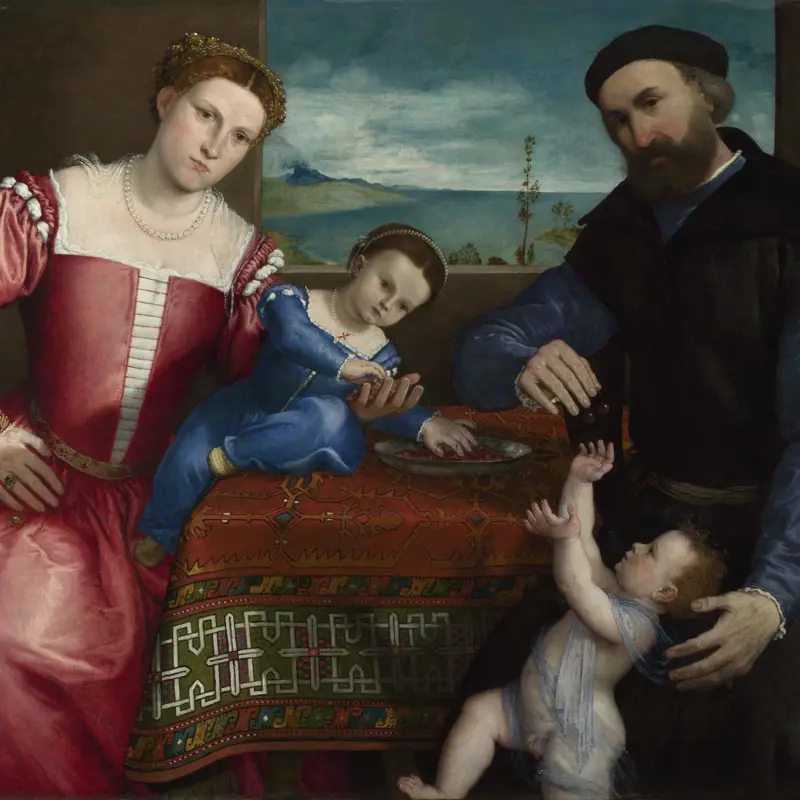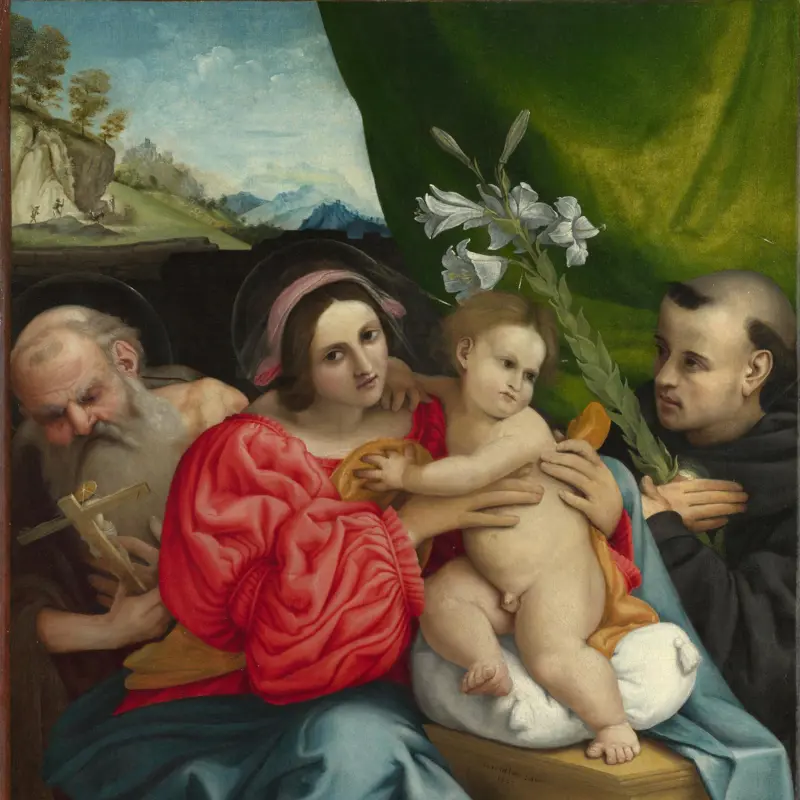Lorenzo Lotto, 'Giovanni Agostino della Torre and his Son, Niccolò', about 1515-16
About the work
Overview
Giovanni Agostino della Torre was a distinguished doctor and citizen of Bergamo. He had taught at the University of Padua, and the costume he wears is official or academic dress. In 1510 he was elected prior of Bergamo’s College of Physicians, an office he held until his death.
The texts on the two square pieces of paper below the inkstand are prescriptions. The paper label on the back cover of the book held by Agostino reads ‘Galienus’, meaning Galen, who was the great medical authority of the ancient world. On one of the pieces of paper in Agostino’s right hand is an inscription that refers to Aesculapius, the physician god of the ancient Greeks and Romans. The portrait is signed and includes a date, which is illegible today but recorded as 1515.
The man behind Agostino is Niccolò, who was 33 in 1516 when his father died. It seems that he was added to what was originally conceived only as a portrait of Agostino, perhaps on the occasion of his father’s death.
Key facts
Details
- Full title
- The Physician Giovanni Agostino della Torre and his Son, Niccolò
- Artist
- Lorenzo Lotto
- Artist dates
- about 1480 - 1556/7
- Date made
- about 1515-16
- Medium and support
- oil on canvas
- Dimensions
- 85 × 68.2 cm
- Inscription summary
- Signed; Dated and inscribed
- Acquisition credit
- Bought, 1862
- Inventory number
- NG699
- Location
- Room 4
- Collection
- Main Collection
- Frame
- 16th-century Italian Frame
Provenance
Additional information
Text extracted from the ‘Provenance’ section of the catalogue entry in Nicholas Penny, ‘National Gallery Catalogues: The Sixteenth Century Italian Paintings’, vol. 1, ‘Paintings from Bergamo, Brescia and Cremona’, London 2004; for further information, see the full catalogue entry.
Exhibition history
-
2011Lorenzo LottoScuderie del Quirinale2 March 2011 - 12 June 2011
-
2018Lorenzo Lotto PortraitsMuseo Nacional del Prado19 June 2018 - 30 September 2018The National Gallery (London)5 November 2018 - 10 February 2019
Bibliography
-
1959Gould, Cecil, National Gallery Catalogues: The Sixteenth Century Venetian School, London 1959
-
1987Gould, Cecil, National Gallery Catalogues: The Sixteenth Century Italian Schools, London 1987
-
2001
C. Baker and T. Henry, The National Gallery: Complete Illustrated Catalogue, London 2001
-
2004
Penny, Nicholas, National Gallery Catalogues: The Sixteenth Century Italian Paintings, 1, Paintings from Bergamo, Brescia and Cremona, London 2004
Frame
This sixteenth-century Italian frame is carved from aged walnut and is designed in the Tuscan style. With its generous proportions, it features an outer moulding that curves inwards, adorned with carved tongue-and-spear motifs. The inner hollow is enriched with fluted designs along with centre discs and spear accents.
A small slip was added to accommodate Lotto’s Giovanni Agostino della Torre and his Son, Niccolò when the frame was acquired in 2010.
About this record
If you know more about this work or have spotted an error, please contact us. Please note that exhibition histories are listed from 2009 onwards. Bibliographies may not be complete; more comprehensive information is available in the National Gallery Library.



